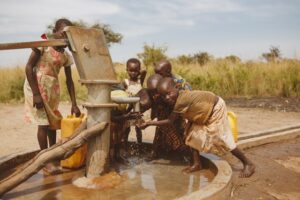Physical Address
23,24,25 & 26, 2nd Floor, Software Technology Park India, Opp: Garware Stadium,MIDC, Chikalthana, Aurangabad, Maharashtra – 431001 India
Physical Address
23,24,25 & 26, 2nd Floor, Software Technology Park India, Opp: Garware Stadium,MIDC, Chikalthana, Aurangabad, Maharashtra – 431001 India

Extreme heat events are becoming the hallmark issue of our time, fueled by rising climate change and affecting disproportionately vulnerable populations across the globe. For billions in South Asia, Southeast Asia, and parts of Africa, health, livelihoods, and economic stability face unprecedented increases in risk. The heat exposure divide between rich and poor, well-resourced and poorly resourced areas, is a stark reminder of the deep inequalities characterising the impact of rising temperatures on these nations.
Unequal Heat Exposure: A Growing Crisis in Developing Nations
Extreme heat events fueled by climate change are intensifying globally. According to a recent study published in Nature, enormous disparities in exposure to heat are evident, with India, China, Indonesia, Nigeria, and Bangladesh leading the list. In 2020, over 1.7 billion people experienced more than 100 days of extreme heat, projected to increase by orders of magnitude unless effective mitigation measures are taken.
Rapid urbanisation, weak infrastructure, and socioeconomic issues contribute to the fact that developing countries bear the full brunt of this crisis. For example, in India and Bangladesh, mortality rates have increased, and energy demand has skyrocketed during heat waves, placing a heavy burden on public resources. In Nigeria, millions of people are at risk of deadly conditions due to unreliable electricity and a lack of cooling infrastructure. This stark inequality calls for targeted interventions to safeguard the most vulnerable populations.
Urban Heat Islands Intensify Vulnerability
Urban areas are vulnerable to extreme heat because of the UHI effect, in which concrete and asphalt retain and amplify heat. Cities in developing countries are now experiencing worse heat crises. In New Delhi, temperatures have risen to nearly 50°C, putting its citizens, particularly those without air conditioning, at significant risk. The increase in days with temperatures exceeding 35°C in Jakarta highlights the compounded risks of intense heat and humidity, which disproportionately impact low-income communities.
High-density populations and a lack of open spaces enhance the UHI effect, so climate-resilient urban planning must be integrated. Strategies include increasing green cover, using reflective building materials, and upgrading cooling infrastructure. However, these require high investment, which is still challenging for low-income nations.
Health Impacts: The Burden of Extreme Heat
Extreme heat and its health implications are both severe and multifaceted. Exposure to high temperatures has been found to cause heat-related illnesses, especially heatstroke and aggravated cardiovascular and respiratory conditions, and vulnerable groups, such as the elderly, children, outdoor workers, and women, are most susceptible to such impacts. In India, it has been reported that women experience a far higher mortality rate from heat-related illnesses due to socioeconomic and physiological factors.
Beyond immediate health effects, extreme heat threatens food security by reducing agricultural productivity, leading to malnutrition in vulnerable populations. In Bangladesh, for example, a surge in electricity demand due to heat waves has strained energy resources, highlighting the interconnected challenges of health, food, and infrastructure under extreme heat stress.
Economic Fallout: Costs and Consequences
Extreme heat has devastating economic implications, particularly for developing economies that depend heavily on labour-intensive sectors. In agriculture and construction, where significant portions of populations in affected nations are employed, heat stress impacts productivity. The International Labour Organization estimates that the loss of full-time jobs globally will reach 80 million by 2030.
In Nigeria, heat-related productivity losses have pushed wages below minimum levels in sectors employing most women, deepening economic inequality. In India, high temperatures reduce crop yields and strain energy infrastructure, causing frequent power outages. These financial losses create a vicious cycle in which limited resources prevent a country from investing in adaptive measures, increasing vulnerability.
References:
https://www.pnas.org/doi/10.1073/pnas.2024792118
https://www.cnn.com/2024/06/27/climate/capital-cities-are-heating-up-intl-hnk/index.html
Banner image:
Photo by Illustrate Digital Ug on Pexels